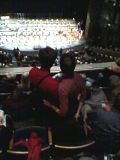 I was on the Berkeley campus Saturday evening for the 2nd of 3 programs given by the Vienna Philharmonic Orchestra. In his pre-concert lecture, Prof. Clemens Hellsberg, 1st violinist & Vienna Phil President, told us about the orchestra's collaborations with Schumann & Brahms, the composers on the program. Prof. Hellsberg also slipped in some dry humor along with many dry facts about the orchestra's history.
I was on the Berkeley campus Saturday evening for the 2nd of 3 programs given by the Vienna Philharmonic Orchestra. In his pre-concert lecture, Prof. Clemens Hellsberg, 1st violinist & Vienna Phil President, told us about the orchestra's collaborations with Schumann & Brahms, the composers on the program. Prof. Hellsberg also slipped in some dry humor along with many dry facts about the orchestra's history.The 2nd Schumann Symphony was performed with a slightly reduced, classical-sized orchestra. I've never heard the Vienna Phil before, so I was fascinated by its transparent string texture & the brilliant woodwind timbres, though a couple of brass hiccups in the opening measures dismayed me. The principal oboe has an unusually distinct sound, piercing, high, wide & reedy. The clarinet solo in the Adagio was beautifully clean & floaty & seemingly effortless. The orchestra's players are very animated & at times look unable to stay seated. The Scherzo felt barely kept in check & always just about to fall out of balance. The timpani made a wonderfully big, bloated roll in the finale. The audience applauded each movement except the Adagio.
The orchestra was full-sized for the Brahms 2. The horns were perfect in the opening, & there was a gorgeous horn solo, the instrument sounding smooth yet brassy. I was very happy whenever another oboe or clarinet solo popped out. The orchestra has great dynamic range, & the strings play with a taut energy. Conductor Semyon Bychkov led the entire program without a score. He always looked engaged with the music, but it was not clear to me by his gestures what his contributions were.
The orchestra ripped into Brahms's Hungarian Dance No. 5 as their encore. Suddenly the strings had a meaty, woody tone & the whole ensemble sounded twice as loud & twice as brilliant. Their intensity & exuberance startled & even frightened me a bit. They made the piece feel new & not over-familiar.
Of course Zellerbach was full for this event, & it was difficult to maneuver around the hall. I sat at the very back of the balcony, where I felt that a lot of the orchestra's sound was simply lost in the cave-like auditorium. There were several small children seated around me. During the performance I heard much whispering, & someone kept opening something made of velcro. A young couple in front of me was especially fidgety. They snacked, drank, whispered, pointed out things in the program to one another & even searched under their seats, all while the music was going on. I brought my binoculars specifically to count the number of women in the ensemble, & I spotted 6 throughout the evening.
§ Cal Performances
Vienna Philharmonic Orchestra
Semyon Bychkov, conductor
Schumann: Symphony No. 2
Brahms: Symphony No. 2
Encore: Brahms: Hungarian Dance No. 5
Sat, Feb 26, 8 pm
Zellerbach Hall
4 comments:
This is an intelligent review. I was there and generally agree--except that I was close enough to see how beautifully the conductor shaped the orchestra's sound with the use of his hands. I'm surprised the sound seemed swallowed up--some friends told me the orchestra's sound seemed too large for Zellerbach.
Bob S.
Pleasant Hill
Yes, I think that "sculpting" would be a good way to describe Maestro Bychkov's gestures. I was far away from the stage, so I am sure that I missed a lot. I find the acoustic in Zellerbach to be not very sympathetic, but I have not sat in many different locations there. I am very glad I got a chance to hear this concert, though.
Your review touches on a phenomenon that I've encountered numerous times in the concert and recital hall, Encore Syndrome. This occurs when the pianist, violinist, singer, or orchestra performs an encore with more verve, abandon, and conviction than the entire program preceding it. I've always assumed that this occurs when the musicians realize that they've conquered the audience, and have nothing left to prove--the "you like me!" effect. And that could indeed account for the thrilling Hungarian Dance performance, though the notion that the VPO has anything to prove to a Zellerbach audience is not wholly convincing.
Perhaps musicians require a whole program to warm up; maybe in the future they could play their programs twice--one right after another on the same evening: Those audience members who set great store by every-note-in-place accuracy should attend the first performance; those seeking a more thrilling ride, the second.
I know what you mean, but I think this is just in the nature of encores & is not a "syndrome." I was shocked in this case because I suddenly felt like I was in the Musikverien on New Years.
In talking with people who heard the other VPO programs, it may be that I heard them on their weakest night.
Post a Comment